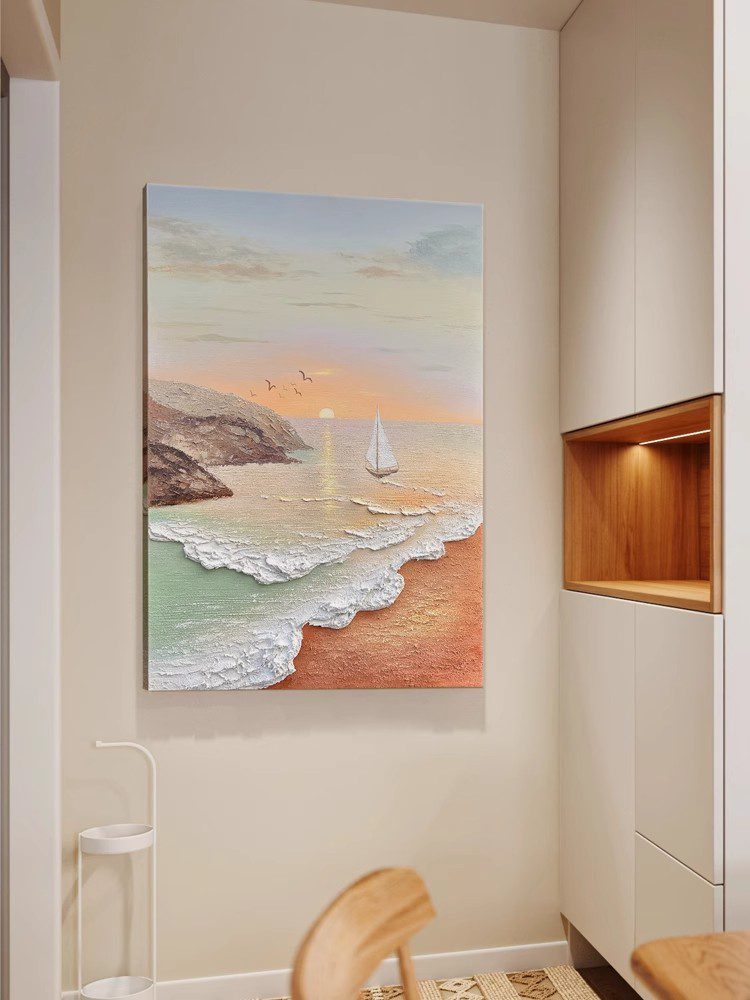The development history of hand-painted oil paintings can be roughly sorted out into the following important stages:
Origin and the Classical period
The predecessor of hand-painted oil painting was the eggcolor painting in European painting before the 15th century. Eggcolor painting was a kind of painting made by mixing egg yolks or egg whites with pigments, often painted on a board covered with plaster. Representative works include Sandro Botticelli’s “Spring” and “The Birth of Venus”, etc. By the 15th century, the Dutch painter Jan van Eyck replaced eggs with flaxseed oil and developed a new type of painting material – oil painting, which got rid of the shortcomings of traditional eggcolor painting such as quick color fading and slow drying. Jan van Eyck is thus called the “Father of oil painting”. Later, oil painting gradually became the main form of painting in the history of Western painting.
During the European Renaissance in the 15th century, humanistic thought, out of criticism of religion, led many painters to observe and directly depict the people, landscapes and objects in life at that time, making religiously themed works carry obvious secular elements of reality. In terms of expression techniques, it advocated facing nature, taking nature as a teacher, rationally interpreting nature, and introducing scientific achievements to shape artistic images. Perspective and anatomy became the two main pillars of Renaissance art modeling. During this period, important painting schools such as the Florentine School and the Venetian School emerged, with representative painters including Leonardo Da Vinci, Michelangelo, Raphael, Titian, etc.
The late Classicism of the 17th century
By the 17th century, some oil paintings began to emphasize the sense of light, creating a sense of light through the contrast of warm and cool colors, the contrast of light and dark intensity, and the contrast of thickness and layering, thus forming a dramatic atmosphere in the picture. The Dutch painter Rembrandt used the sense of light in his paintings as a means to represent a person’s mental state. In the numerous portraits he created, the figures were all enveloped by large areas of darkness, with only the important parts such as the face and hands showing distinct brightness. The Italian painter Caravaggio emphasized the contrast of light and shade in his paintings, often using large areas of darkness in the background plane to set off the bright figures in the foreground, making people feel that the light in the painting is dazzling. At the same time, the application of brushstrokes was also emphasized and explored by many painters, and brushstrokes themselves also possess artistic expressiveness.
The modern period of the 19th century
The development of oil painting had a new trend in the 19th century, mainly reflected in the transformation of oil painting colors. The British painter Constanbury was the first to directly sketch oil paintings outdoors, obtaining a rich sense of color. He used fine brushstrokes to juxtopose colors in some parts, making them blend into more vivid color blocks, and the picture was much brighter than the classical brown tone. At the end of the 19th century, Western oil painting underwent fundamental changes. Oil painting no longer took imitating and reproducing nature as the principle of artistic creation. Instead, it took the freely constructed oil painting artistic images by painters as the new reality, used oil painting as the medium to express their spiritual and emotional world, and constructed works through methods such as imagination and fantasy. During this period, an important branch in the history of Western oil painting – Impressionism – emerged. In the last 30 years of the 19th century, it became the mainstream of French art and influenced the entire European and American art scene. Representative painters included Monet, Georges Seurat, Cezanne, Van Gogh, etc.
The modern period of the 20th century
In modern and contemporary oil paintings of the 20th century, different artistic concepts have formed different schools, and the formal language of oil paintings has been highly valued. From the history of Western oil painting in the past few hundred years, it can be seen that oil painting has grown stronger in modern times, and countless schools such as Expressionism, Cubism and Fauvism have emerged and replaced each other one after another. Abstract painting generally refers to the painting style of the 20th century that aimed to break away from imitating nature. It encompasses multiple schools and is not the name of a single school. Its formation has evolved over a long period of continuous development. Abstract oil painting fundamentally broke through the traditional realistic principles and techniques of oil painting. It unfolded the picture expression in an abstract painting form, marking the entry of Western oil painting into the modern era. One of the other important modern art schools is Expressionism. Artists focus on expressing their inner emotions through their works and neglect the imitation of the form of the depicted objects. As a result, they often present a distortion and abstraction of reality. For instance, Munch’s “The Scream” is a representative of this.
